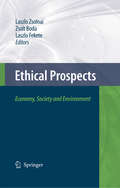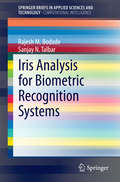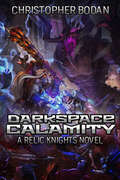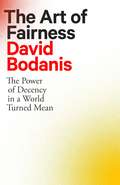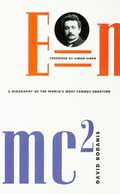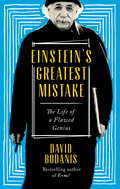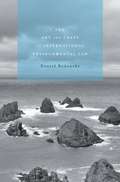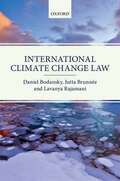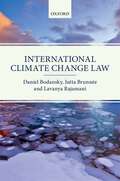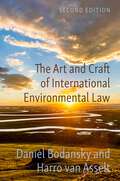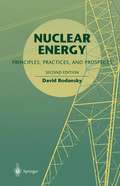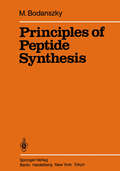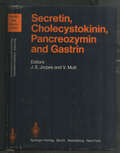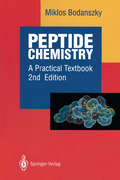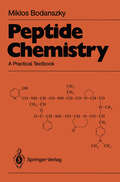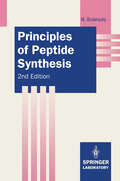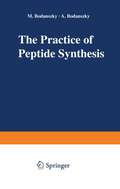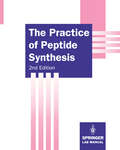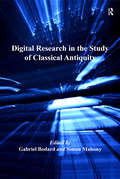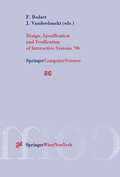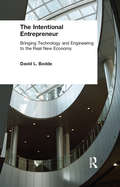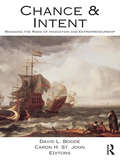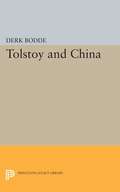- Table View
- List View
Ethical Prospects: Economy, Society and Environment
by Zsolt Boda Laszlo FeketeEthical Prospects: Economy, Society, and Environment aims to present and summarize new perspectives and leading-edge results in ethics reflecting on interconnected economic, social and environmental issues. The yearbook reports on innovative practices and policy reforms and provides a forum for discussion about groundbreaking theories. The main function of the yearbook is to present ideas and initiatives that lead toward responsible business practices, policies for the common good and ecological sustainability. It seeks to form a value-community of scholars, practitioners and policymakers engaged in genuine ethics in business, environmental management, and public policy.
Iris Analysis for Biometric Recognition Systems (SpringerBriefs in Applied Sciences and Technology)
by Rajesh M. Bodade Sanjay N. TalbarThe book presents three most significant areas in Biometrics and Pattern Recognition. A step-by-step approach for design and implementation of Dual Tree Complex Wavelet Transform (DTCWT) plus Rotated Complex Wavelet Filters (RCWF) is discussed in detail. In addition to the above, the book provides detailed analysis of iris images and two methods of iris segmentation. It also discusses simplified study of some subspace-based methods and distance measures for iris recognition backed by empirical studies and statistical success verifications.
Darkspace Calamity
by Christopher Bodan&“Relic Knights fans rejoice! Follow your favorite racer on a nonstop roller coaster to save the last galaxy from the Calamity. Sci-fi and fantasy blend in this must-read adventure.&” —D. W. Vogel, author of the bestselling Horizon Alpha series The Calamity is coming. Darkspace spreads across the sky as esper—powerful magic that gives everything form and life—is consumed. One by one, the galaxies have vanished. Only a single galaxy remains, and its inhabitants know the Calamity could strike at any moment. Princess Malya never wanted much to do with the fate of the galaxy. She&’d be happy just to travel around the galaxy participating in the most risky and exhilarating sport in existence. But then a pirate captain tells her that she&’s key to his plan that just might stop the Calamity. It&’s a vague plan, and honestly a complete long shot. Even if Malya believes the cryptic prophecy of an insane space witch, the plan requires noble paladins and bloodthirsty corsairs to actually cooperate. With such impossible odds, Malya almost wants to keep running and leave saving the universe to anyone else. But even Malya cannot outrun the Calamity. To protect the people she loves and maybe even the galaxy itself, she must pull off her craziest stunt yet."The fate of the Last Galaxy rides fast and dangerous on Darkspace Calamity's colorful cast of characters." —Christopher Keene, author of the Dream State Saga
The Art of Fairness: The Power of Decency in a World Turned Mean
by David Bodanis'David Bodanis is an enthralling storyteller. Prepare to be taken on a surprising, wide-ranging and ultimately inspiring journey to explore what makes us human' Tim HarfordCan you succeed without being a terrible person? We often think not: recognising that, as the old saying has it, 'nice guys finish last'. But does that mean you have to go to the other extreme, and be a bully or Machiavellian to get anything done?In THE ART OF FAIRNESS, David Bodanis uses thrilling historical case studies to show there's a better path, leading neatly in between. He reveals how it was fairness, applied with skill, that led the Empire State Building to be constructed in barely a year - and how the same techniques brought a quiet English debutante to become an acclaimed jungle guerrilla fighter. In ten vivid profiles - featuring pilots, presidents, and even the producer of Game of Thrones - we see that the path to greatness doesn't require crushing displays of power or tyrannical ego. Simple fair decency can prevail.With surprising insights from across history - including the downfall of the very man who popularised the phrase 'nice guys finish last' - THE ART OF FAIRNESS charts a refreshing and sustainable new approach to cultivating integrity and influence.
E=mc2: A Biography of the World's Most Famous Equation
by David BodanisGenerations have grown up knowing that the equation E=mc2 changed the shape of our world, but never understanding what it actually means, why it was so significant, and how it informs our daily lives today--governing, as it does, everything from the atomic bomb to a television's cathode ray tube to the carbon dating of prehistoric paintings. In this book, David Bodanis writes the "biography" of one of the greatest scientific discoveries in history--that the realms of energy and matter are inescapably linked--and, through his skill as a writer and teacher, he turns a seemingly impenetrable theory into a dramatic human achievement and an uncommonly good story.
Einstein's Greatest Mistake: The Life of a Flawed Genius
by David BodanisWidely considered the greatest genius of all time, Albert Einstein revolutionised our understanding of the cosmos with his general theory of relativity and helped to lead us into the atomic age. Yet in the final decades of his life he was also ignored by most working scientists, his ideas opposed by even his closest friends. This stunning downfall can be traced to Einstein's earliest successes and to personal qualities that were at first his best assets. Einstein's imagination and self-confidence served him well as he sought to reveal the universe's structure, but when it came to newer revelations in the field of quantum mechanics, these same traits undermined his quest for the ultimate truth. David Bodanis traces the arc of Einstein's intellectual development across his professional and personal life, showing how Einstein's confidence in his own powers of intuition proved to be both his greatest strength and his ultimate undoing. He was a fallible genius. An intimate and enlightening biography of the celebrated physicist, Einstein's Greatest Mistake reveals how much we owe Einstein today - and how much more he might have achieved if not for his all-too-human flaws.
The Art and Craft of International Environmental Law
by Daniel BodanskyInternational environmental law is often closer to home than we know, affecting the food we eat, the products we buy, and even the air we breathe. Drawing on more than two decades of experience as a government negotiator, consultant, and academic, Daniel Bodansky brings a real-world perspective on the processes by which international environmental law develops, and influences the behavior of state and non-state actors.
International Climate Change Law
by Daniel Bodansky Jutta Brunnée Lavanya RajamaniThis textbook, by three experts in the field, provides a comprehensive overview of international climate change law. Climate change is one of the fundamental challenges facing the world today, and is the cause of significant international concern. In response, states have created an international climate regime. The treaties that comprise the regime - the 1992 United Nations Framework Convention on Climate Change, the 1997 Kyoto Protocol and the 2015 Paris Agreement establish a system of governance to address climate change and its impacts. This book provides a clear analytical guide to the climate regime, as well as other relevant international legal rules. The book begins by locating international climate change law within the broader context of international law and international environmental law. It considers the evolution of the international climate change regime, and the process of law-making that has led to it. It examines the key provisions of the Framework Convention, the Kyoto Protocol and the Paris Agreement. It analyses the principles and obligations that underpin the climate regime, as well as the elaborate institutional and governance architecture that has been created at successive international conferences to develop commitments and promote transparency and compliance. The final two chapters address the polycentric nature of international climate change law, as well as the intersections of international climate change law with other areas of international regulation. This book is an essential introduction to international climate change law for students, scholars and negotiators.
International Climate Change Law
by Daniel Bodansky Jutta Brunnée Lavanya RajamaniThis textbook, by three experts in the field, provides a comprehensive overview of international climate change law. Climate change is one of the fundamental challenges facing the world today, and is the cause of significant international concern. In response, states have created an international climate regime. The treaties that comprise the regime - the 1992 United Nations Framework Convention on Climate Change, the 1997 Kyoto Protocol and the 2015 Paris Agreement establish a system of governance to address climate change and its impacts. This book provides a clear analytical guide to the climate regime, as well as other relevant international legal rules. The book begins by locating international climate change law within the broader context of international law and international environmental law. It considers the evolution of the international climate change regime, and the process of law-making that has led to it. It examines the key provisions of the Framework Convention, the Kyoto Protocol and the Paris Agreement. It analyses the principles and obligations that underpin the climate regime, as well as the elaborate institutional and governance architecture that has been created at successive international conferences to develop commitments and promote transparency and compliance. The final two chapters address the polycentric nature of international climate change law, as well as the intersections of international climate change law with other areas of international regulation. This book is an essential introduction to international climate change law for students, scholars and negotiators.
The Art and Craft of International Environmental Law
by Daniel Bodansky Harro van AsseltIn countless ways we are affected by international environmental norms: some social, others legal; some quite general, others very specific. For example, the norms limiting the refrigerants used in air conditioners have been agreed upon in legal form internationally, and are mandated and enforced by national governments. The sustainable fishery and forestry standards used by Carrefour and Ikea were developed more informally by environmental groups and businesses, and are applied to producers through supply-chain contracts, without any government involvement. The reluctance to eat tuna fish or own elephant ivory reflects more general social norms, disseminated through education and culture. How and why do these norms arise? In what ways do they affect behavior? Do they change what states and individuals actually do and, if so, why? How effective are they in solving international environmental problems? In the second edition of The Art and Craft of International Environmental Law, Daniel Bodansky and Harro van Asselt explore these and other questions. Revisions cover the numerous developments spanning the 13 years since the first edition was published. New chapters address the growing role of environmental NGOs and the increasingly complex architecture of environmental law involving multiple institutions, levels of governance, and actors. Recent research has been incorporated on treaty design and policy implementation and effectiveness, and greater attention has been given to the role of the judiciary in standard-setting, implementation, and enforcement. A sophisticated yet highly readable introduction to how international environmental law works (and sometimes doesn't work), this book is essential reading for a wide audience.
Nuclear Energy: Principles, Practices, and Prospects
by David BodanskyThis second edition represents an extensive revision of the ?rst edition, - though the motivation for the book and the intended audiences, as described inthepreviouspreface,remainthesame. Theoveralllengthhasbeenincreased substantially, with revised or expanded discussions of a number of topics, - cluding Yucca Mountain repository plans, new reactor designs, health e?ects of radiation, costs of electricity, and dangers from terrorism and weapons p- liferation. The overall status of nuclear power has changed rather little over the past eight years. Nuclear reactor construction remains at a very low ebb in much of the world, with the exception of Asia, while nuclear power’s share of the electricity supply continues to be about 75% in France and 20% in the United States. However,therearesignsofaheightenedinterestinconsideringpossible nuclear growth. In the late 1990s, the U. S. Department of Energy began new programs to stimulate research and planning for future reactors, and many candidate designs are now contending—at least on paper—to be the next generation leaders. Outside the United States, the commercial development ofthePebbleBedModularReactorisbeingpursuedinSouthAfrica,aFrench- German consortium has won an order from Finlandfor the long-plannedEPR (European Pressurized Water Reactor), and new reactors have been built or planned in Asia. In an unanticipated positive development for nuclear energy, the capacity factor of U. S. reactors has increased dramatically in recent years, and most operating reactors now appear headed for 20-year license renewals.
Principles of Peptide Synthesis (Reactivity and Structure: Concepts in Organic Chemistry #16)
by M. BodanszkyA look at the shelves of a major library awakens doubts in the author of this small volume about the importance of writing a new introduction to peptide synthesis. This rather narrow area of bio-organic chemistry already has received considerable attention. A whole series of books deals with the synthesis of peptides. Some of these are textbooks written to support lecture courses on peptide synthesis. Others try to help the beginner, otherwise well versed in organic chemistry, to embark on some experimental project that requires the construction of peptide chains. Not less useful are the monographs which were compiled to aid the adept practitioner and to provide him with references to the growing literature of a very active field. Is there any need for a new book on peptide synthesis? Should we add a new volume to an already impressive and certainly useful series? The answer is not obvious. The author has already participated in two similar en deavors. The first edition! of "Peptide Synthesis", with M. A. Ondetti as coauthor, was meant to serve as an introduction for the beginner. It was rather well received by researchers who joined the field of peptide chemistry and were looking for initiation. While working on the 2 second edition with Drs. Klausner and Ondetti, we became painfully aware of the impossibility of the task.
Secretin, Cholecystokinin, Pancreozymin and Gastrin (Handbook of Experimental Pharmacology #34)
by M. Bodanszky R. Carratu D. A. Dreiling R. Fussgänger J. D. Jamieson H. D. Janowitz J. E. Jorpes V. Mutt E. F. Pfeiffer J. Plessier M. L. Ramorino S. Rapits A. Torsoli M. J. ZimmermannIn the beginning of this century physiology witnessed the creation of a new concept, the hormonal regulation of the work of the digestive organs. It was found that such essential functions as the flow of pancreatic juice and emptying of bile into the intestine were regulated by two hormones, secretin and cholecystokinin, respectively. Already in 1925 French authors attempted to measure the functional capacity of the exocrine pancreas by means of stimulation with secretin. The use fulness of the secretin test in this connection was definitely established by Scandinavian workers in the 1930's. In spite of the difficulties in obtaining secretin American authors succeeded in keeping the interest in the secretin test alive. The development in the 1950's of counter-current, ion exchange and chromato graphic techniques offered new possibilities in this field. The intestinal hormones were known to be relatively low molecular peptides and these could now be isolated in pure form. Thus secretin was isolated in 1961, and cholecystokinin in 1964. The newly developed methods for peptide analysis likewise soon brought us full information about the primary structure of the peptides. Gastrin, the specific stimulant of the gastric acid secretion, which was discovered in 1905 and acknowledged as a hormone in 1938, was the first of the gastrointestinal hormones for which the structure became known. This was in 1964. Synthesis soon followed. These developments are reviewed in the first chapter of the present volume.
Peptide Chemistry: A Practical Textbook
by Miklos BodanszkyA continued interest in Peptide Chemistry prompted the revision of the first edition of this book. This provided an opportunity to update several details. I am grateful to colleagues who were kind enough to inform me of errors, typographical and other, they had discovered in the first edi tion. These have now been corrected, as were certain shortcomings in language and style pointed out by my daughter, Dr. Eva Bodanszky. In 1991 the excellent The Chemical Synthesis of Peptides by John Jones (Oxford University Press, 1991) appeared. It covers, in part, the same field, but is different enough from Peptide Chemistry, to justify publication of a revised edition of the latter. Princeton, July 1993 M. Bodanszky Preface to the First Edition Nature applied peptides for a great variety of specific functions. The specificity provided by the individual character of each amino acid is further ehanced by the combination of several amino acids into larger molecules. Peptides therefore can act as chemical messengers, neuro transmitters, as highly specific stimulators and inhibitors, regulating var ious life-processes. Entire classes of biologically active compounds, such as the opioid peptides or the gastrointestinal hormones emerged within short periods of time and it is unlikely that the rapid succession of discoveries of important new peptides would come to a sudden halt. In fact, our knowledge of the field is probably still in an early stage of development. Peptides also gained importance in our everyday life.
Principles of Peptide Synthesis (Springer Lab Manuals)
by Miklos BodanszkyPrinciples of Peptide Synthesis is a very successful book by one of the pioneers of contemporary bioorganic synthesis. Its first edition proved a valuable source that is kept close to the work bench for frequent consulting. Any researcher planning the formation of the peptide bond, be it for the synthesis of a peptide chain or a cyclic peptide, benefits from the author's experience. The concise and critical treatment of the steps involved: protection, activation and bond formation require careful planning to avoid racemization and undesired side reactions. The second edition has been completely revised and updated. New procedures that have been developed since the first edition was published and that did not fit into the original are added in a separate chapter. This separation of old and new make it possible to assess new ideas and discern novel trends.
The Practice of Peptide Synthesis (Reactivity and Structure: Concepts in Organic Chemistry #21)
by Miklos Bodanszky Agnes BodanszkyDuring the years 1980-81, as guests of the Deutsches Woll forschungsinstitut in Aachen, Germany, we were working on a small book entitled, "Principles of Peptide Synthesis". In the library of the Institute we noted that the volumes of Houben-Weyl's Handbuch der Organischen Chemie dealing with peptide synthesis were so much in use that they were ready to fall apart because the researchers of the Institute consulted them with amazing regularity. They were looking for references, but even more for experimental details which could be adapted to the particular problem they happened to face. In planning a new synthetic endeavor they tried to lean on the experience of others in analogous situations. This suggested to us that a smaller and hence more tractable book may be needed, a volume which can be kept on or near the bench to make examples of funda mental methods readily available in the laboratory. Such a collection could save numerous short trips to the library, a point particularly important where a library well equipped with the sources of the literature of peptide synthesis is not near at hand. Also, we thought that the envisaged book may be welcome by those who are more versed in English than in German. To our best knowledge no similar publi cation is available.
The Practice of Peptide Synthesis (Springer Lab Manuals)
by Miklos Bodanszky Agnes BodanszkyDuring the years 1980-81, as guests of the Deutsches Wollforschungsinstitut in Aachen, Germany, we were working on a small book entitled, "Principles of Peptide Synthesis". In the library of the Institute we noted that the volumes of Houben-Weyl's Handbuch der Organischen Chemie dealing with peptide synthesis were so much in use that they were ready to fall apart because the researchers of the Institute consulted them with amazing regularity. They were looking for references, but even more for experimental details which could be adapted to the particular problem they happened to face. In planning a new synthetic endeavor they tried to lean on the experience of others in analogous situations. This suggested to us that a smaller and hence more tractable book may be needed, a volume which can be kept on or near the bench to make examples of fundamental methods readily available in the laboratory. Such a collection could save numerous short trips to the library, a point particularly important where a library well equipped with the sources of the literature of peptide synthesis is not near at hand. Also, we thought that the envisaged book may be welcome by those who are more versed in English than in German. To the best of our knowledge no similar publication is available.
Digital Research in the Study of Classical Antiquity (Digital Research in the Arts and Humanities)
by Gabriel Bodard Simon MahonyThis book explores the challenges and opportunities presented to Classical scholarship by digital practice and resources. Drawing on the expertise of a community of scholars who use innovative methods and technologies, it shows that traditionally rigorous scholarship is as central to digital research as it is to mainstream Classical Studies. The chapters in this edited collection cover many subjects, including text and data markup, data management, network analysis, pedagogical theory and the Social and Semantic Web, illustrating the range of methods that enrich the many facets of the study of the ancient world. This volume exemplifies the collaborative and interdisciplinary nature that is at the heart of Classical Studies.
Design, Specification and Verification of Interactive Systems ’96: Proceedings of the Eurographics Workshop in Namur, Belgium, June 5–7, 1996 (Eurographics)
by Francois Bodart Jean VanderdoncktMaking systems easier to use implies an ever increasing complexity in managing communication between users and applications. Indeed an increasing part of the application code is devoted to the user interface portion. In order to manage this complexity, it is important to have tools, notations, and methodologies which support the designer’s work during the refinement process from specification to implementation. Selected revised papers from the Eurographics workshop in Namur review the state of the art in this area, comparing the different existing approaches to this field in order to identify the principle requirements and the most suitable notations, and indicate the meaningful results which can be obtained from them.
The Intentional Entrepreneur: Bringing Technology and Engineering to the Real New Economy
by David L. BoddeThe Intentional Entrepreneur will help technology professionals and student of business, engineering, or science learn the art of entrepreneurship. David Bodde emphasizes the real-world experience of men and women who are creating new ventures that will survive in the post-bubble economy. The book adds structure and context to its stories with chapters interpreting recent research on business models, marketing, new venture finance, and intellectual property. Unlike most books on entrepreneurship, The Intentional Entrepreneur gives special emphasis to technology markets throughout.
The Intentional Entrepreneur: Bringing Technology and Engineering to the Real New Economy
by David L. BoddeThe Intentional Entrepreneur will help technology professionals and student of business, engineering, or science learn the art of entrepreneurship. David Bodde emphasizes the real-world experience of men and women who are creating new ventures that will survive in the post-bubble economy. The book adds structure and context to its stories with chapters interpreting recent research on business models, marketing, new venture finance, and intellectual property. Unlike most books on entrepreneurship, The Intentional Entrepreneur gives special emphasis to technology markets throughout.
Chance and Intent: Managing the Risks of Innovation and Entrepreneurship
by David L. Bodde Caron H. St. JohnA compact and readable book will help executives, entrepreneurs, and venture investors learn to search out and plan for those enterprise hazards that reside outside the bell curve, the conventional domain of risk: Uncertainty, where outcomes can be characterized in advance, reliable estimates cannot be made for the likelihood that they will occur; Ambiguity, where the events and outcomes cannot be well characterized, in some cases because we cannot imagine them and in others because characterization depends upon the institutional interests or cultural values of the observer; and, Ignorance, where neither likelihood estimates nor well-characterized events enjoy much credibility. This edited volume emphasizes practical strategies for understanding and managing the hazards of the new venture in light of recent research. It will help corporate innovators, entrepreneurs, and investors employ a wider spectrum of risk management strategies than is now possible.
Chance and Intent: Managing the Risks of Innovation and Entrepreneurship
by David L. Bodde Caron H. St. JohnA compact and readable book will help executives, entrepreneurs, and venture investors learn to search out and plan for those enterprise hazards that reside outside the bell curve, the conventional domain of risk: Uncertainty, where outcomes can be characterized in advance, reliable estimates cannot be made for the likelihood that they will occur; Ambiguity, where the events and outcomes cannot be well characterized, in some cases because we cannot imagine them and in others because characterization depends upon the institutional interests or cultural values of the observer; and, Ignorance, where neither likelihood estimates nor well-characterized events enjoy much credibility. This edited volume emphasizes practical strategies for understanding and managing the hazards of the new venture in light of recent research. It will help corporate innovators, entrepreneurs, and investors employ a wider spectrum of risk management strategies than is now possible.
Tolstoy and China
by Derk BoddeThis book on the impact of Chinese civilization upon Tolstoy's thinking and writing reveals new resources in the study of a great Russian novelist. Making use of newly available Russian materials, Mr. Bodde explores Tolstoy’s correspondence and his reading and writing on Chinese subjects to determine his conception of Chinese culture and how deeply it affected his thought in such fields as music, politics, ethics.Originally published in 1950.The Princeton Legacy Library uses the latest print-on-demand technology to again make available previously out-of-print books from the distinguished backlist of Princeton University Press. These editions preserve the original texts of these important books while presenting them in durable paperback and hardcover editions. The goal of the Princeton Legacy Library is to vastly increase access to the rich scholarly heritage found in the thousands of books published by Princeton University Press since its founding in 1905.
